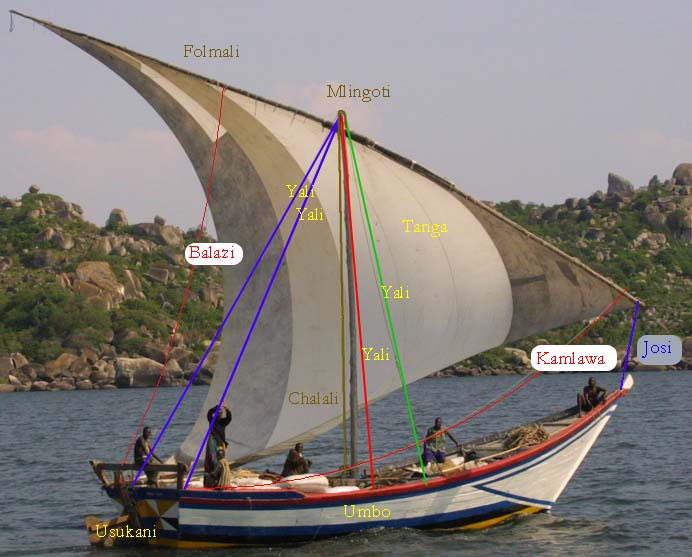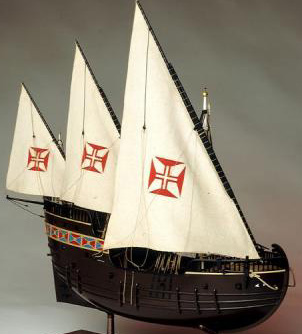
Crtd 08-11-05 Lastedit 18-01-21
Operating a Sailing Dhow
A 13 to 18 meter Victoria Lake cargo dhow normally has 6 to 8 crew. When you
have a winch to lift the sail and no cargo to handle, 3 crew can handle it, 2
can reach a safe place when one gets disabled.
Go to: [YouTube version of Dutch TV broadcast � Our Dhow Sailing (scroll to 4:50)]
Basic terms (see picture below). In the lateen rig, the gaff (folmali) is hoisted at its middle to the mast top by the chalali (halyard). Then its front end is pulled down to the bow by the josi. Near the josi departs also the kamlawa, pulling the down-front end of the folmali rearward. The balazi prevents the top half of the folmali from bending leeward in strong wind. The sheet pulling the rear down side of the sail to the stern is called demani. A folmali consists of two joined young eucalyptus stems, and bends smoothly. The mast (mlingoti) is made of an older eucalyptus stem. (Dhow logbook: Making Mast and Gaff) Not meant to bend, the mast is shored up with four yali (stays). The front two of them (here green and red) are always spanned at the luff (windward) side.

Go to: Our dhow [video � Our Dhow Sailing]
The dhow has no keel and can not go against the wind. From the point in the middle of the picture below, directions in the red sector are not feasible. At beam reach, the extreme, drift is 10 to 20 percent., so it looks as if you are going against the wind but you are not.
Changing sail side from one board to another is intricate. Tacking (turning windward to get the wind on the other board) is impossible. You have to turn the other way: gybe. The intriguing procedure of lateen gybing is explained below
Standard Wind Patterns on Lake Victoria
The standard winds are such that while sailing on the lake you should stay within 50 km from the lake shores to profit from the daily pattern of thermal winds. In the middle of the lake, you often have no wind at all, or from directions of which no predictions are available. Relatively warm air tends to rise - tending to escalate into tropical rainstorms. On the earth surface this rising warm air is replaced by relatively cold air (which is heavier). The lake water is not much influenced by the daily heat of the sun. Under the sun the land surface, now rain forests are largely destroyed, gets too hot to walk on bare feet. And it gets much colder than the lake water in the night. So, the daily pattern is:
Picture above: afternoon, evening (land is heated by sun and warmer
than lake)
Ground wind: from the lake (high altitude wind: reverse)
Development: rising, hence cooling warm air makes rain storms on land.
Picture above: late night, morning (land is cooled below lake water
temperature)
Wind: from the land (high altitude wind: reverse)
Development: rising, hence cooling warm air makes rain storms above the lake.
Go to:
Pictures
of Storms
Go to:
More about Lake Victoria
Putting the Sail

You need banana leaves!
The red ropes are permanent ties of front edge of sail to folmali. Then banana leaves tie the rest of the sail tightly rolled to the folmali [� Video: The Start! Breaking the Banana Leaves]
Crtd 07-09-24 Lastedit 18-01-21
Lateen Gibing Explained
For rope and wire names see top of page

Dow over port: blue: josi, red: kamlawa, green: demani
Kamlawa (red) hauled from starboard to port
Kamlawa pulls folmali vertical, demani, balazi (not shown) released
Boat turns off wind
The supreme moment: between 4 and 5 folmali flips from port to starboard over mast-top. Demani (green) walked from port to starboard rounding the mast and the folmali
Pull all and you are over starboard
The transition from 4 to 5 minimally requires Bf 2 wind to blow
the folmali free from the mast. Under Bf 2, when you have a big dhow: no gybing!
During the operation also the yali (stays) have to be moved from the
starboard to the port side.

The backstays (blue) do not move. Going to stage 2 the backward starboard front stay (red) is untied on deck and moved to the opposite board to become the forward port front stay. Going to stage 6 the forward starboard front stay (green) is untied on deck and moved to the opposite board to become the backward port front stay.
Lateen rigged caravels were used in the Portuguese naval explorations initiated by Henry the Navigator. Bartholomeus Dias and Vasco da Gama, used them. Changing boards, caravels had three lateen rigs to gybe, which must have required quite some crew training. We have some technical doubts about the Portuguese caravel model we found on internet. For instance, we do not believe you can gybe if your mast top sticks out so high above the gaff (folmali). But the model is beautiful and not far off:

 Photo left: model of lateen rigged 15th century
Portuguese caravel
Photo left: model of lateen rigged 15th century
Portuguese caravel
(Bartolomeu Dias, Vasco da Gama)